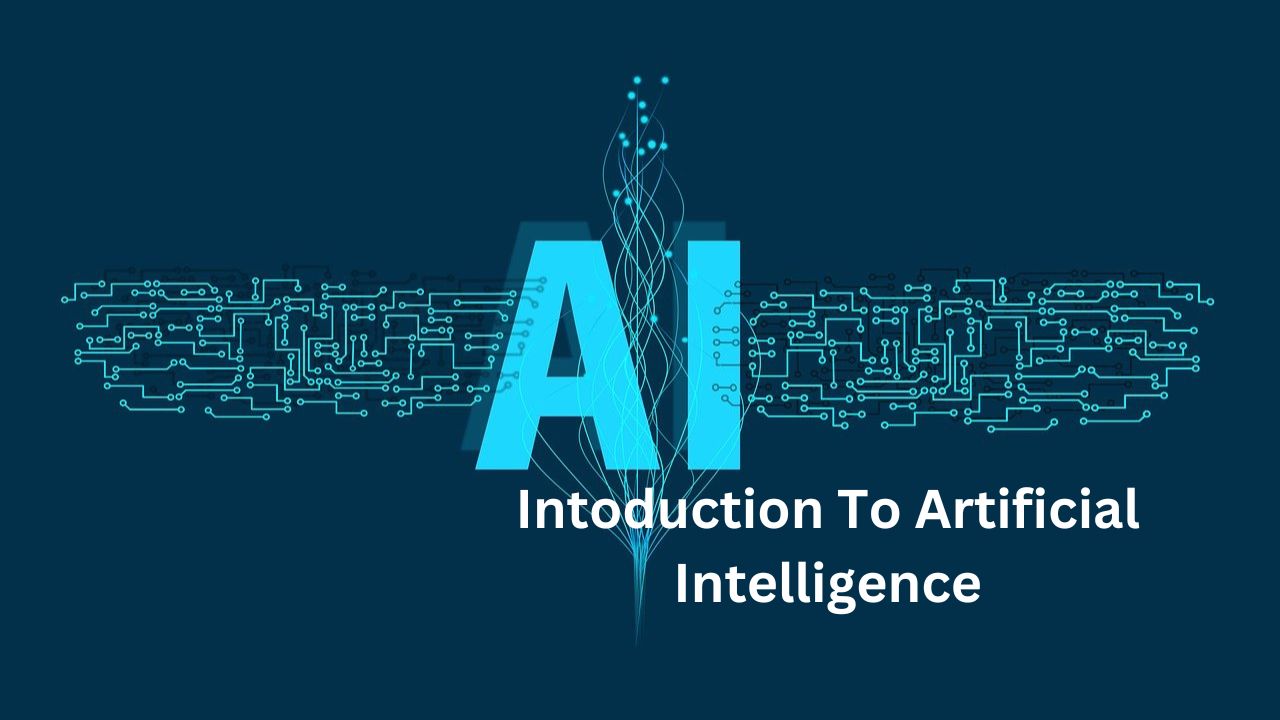Introduction To Artificial Intelligence:
Artificial intelligence (AI) is a vast and dynamic field, often shrouded in mystery and futuristic expectations. At its core, however, AI simply refers to the ability of machines to exhibit intelligent behavior, mimicking human-like capabilities such as learning, problem-solving, and decision-making.
While the term “AI” encompasses a wide range of approaches, some key concepts underpin its workings:
- Machine learning: AI systems can learn from data, improving their performance over time without explicit programming.
- Algorithms: Complex mathematical formulas instruct the AI on how to process information and make decisions.
- Data: The fuel for AI, massive amounts of data are crucial for training and refining AI models.
This article provides an overview of AI, its definition, history, different types, applications across industries, ethical considerations surrounding its implementation, and future trends shaping the AI landscape.
By exploring these key aspects, readers can gain a comprehensive understanding of the role AI plays in society and its implications for the future.
What is Artificial Intelligence?
Artificial intelligence (AI) refers to machines that are programmed to imitate human intelligence.
This includes abilities like learning, reasoning, problem-solving, perception, and language comprehension.
It is like the secret sauce that makes machines smarter. It’s the brainpower that allows computers to mimic human intelligence and learn from data, make decisions, and solve problems.
History of Artificial Intelligence
The idea of objects without life having intelligence has been around for a long time. Over the years, many thinkers, from Aristotle to Ramon Llull to Descartes and Bayes, have used symbols to describe human thought processes, laying the groundwork for concepts like general knowledge representation in AI.
In the early 20th century, the groundwork for modern computers was laid. In 1836, Charles Babbage and Augusta Ada King designed the first programmable machine.
In the 1940s, John Von Neumann came up with the idea of stored-program computers, and McCulloch and Pitts developed neural networks.
In the 1950s, the field of AI began to take shape. Alan Turing created a test to determine if a computer could exhibit intelligence. In 1956, a conference at Dartmouth College marked the official start of modern AI, with pioneers like McCarthy, Minsky, and Selfridge in attendance.
Newell and Simon developed the first AI program, the Logic Theorist. In the following decades, there were significant advances in AI, such as the General Problem Solver algorithm and the development of Lisp.
However, the achievement of artificial general intelligence remained elusive, leading to periods known as AI winters.
In the late 1990s, a resurgence in AI research led to breakthroughs in NLP, computer vision, and machine learning.
The 2000s saw further advances in AI, with the launch of products like Google’s search engine and Amazon’s recommendation engine.
The 2010s brought developments like Siri, Watson’s victories on Jeopardy, and the launch of TensorFlow.
The current decade has seen the rise of generative AI, which can create new content based on prompts, although the technology is still in its early stages.
Different Types Of Artificial Intelligence
1: Reactive machines are AI systems that are task-specific and do not have memory. An example is Deep Blue, the IBM chess program that defeated Garry Kasparov in the 1990s.
Deep Blue can recognize pieces on a chessboard and make predictions, but it cannot learn from past experiences.
2: Limited memory AI systems have memory and can learn from past experiences to make future decisions. Some decision-making functions in self-driving cars operate this way.
3: Theory of mind refers to AI systems that can understand emotions and human intentions. This social intelligence is crucial for AI systems to work effectively in human teams.
4: Self-awareness AI systems have a sense of self and consciousness, understanding their current state. However, this type of AI does not currently exist.
Applications of Artificial Intelligence
In Healthcare
AI is transforming healthcare by aiding in diagnosis, personalized treatment plans, and medical research. It’s like having a medical Sherlock Holmes who can deduce illnesses and recommend the best treatment options.
In Finance
From fraud detection to stock market predictions, AI is a game-changer in the finance world.
It’s like having a financial wizard who can crunch numbers faster than you can say “bull market.”
In Autonomous Vehicles
Self-driving cars are the poster child of AI applications. They use AI to navigate roads, detect obstacles, and make split-second decisions.
It’s like having a chauffeur who’s always alert and never gets road rage.
In a nutshell, AI is the cool kid on the block, making our lives easier, smarter, and maybe a bit more thrilling.
Get ready to welcome the robots – they’re here to stay!# Ethical Considerations in Artificial Intelligence.
Image & Audio Generation
Generative AI techniques are being used in businesses to create different types of media like text, images, and audio from text prompts. These techniques can produce a wide variety of content such as photorealistic art, email responses, and screenplays, making the possibilities seem endless.
Data Privacy and Security
When it comes to artificial intelligence, data is the bread and butter. However, with great data comes great responsibility – especially in terms of privacy and security. Ensuring that personal data is handled ethically and securely should be a top priority in the AI landscape.
Biases in AI Algorithms
AI algorithms are only as unbiased as the data they are trained on. Unfortunately, biases can creep in through the data collection process or even inadvertently within the algorithms themselves. Recognizing and addressing these biases is crucial to ensure AI systems make fair and just decisions.
Job Displacement and Economic Impacts
As AI technology advances, there is a valid concern about job displacement and its broader economic impact. While AI can automate certain tasks, it also has the potential to create new job opportunities. To delve deeper into this topic, utilizing a basl for academic work can help in analyzing and documenting the nuances of AI’s impact on the economy. Striking a balance between technological progress and workforce sustainability is key.
Future Trends in Artificial Intelligence
Advancements in Deep Learning
Deep learning is at the forefront of AI innovation, allowing machines to learn complex patterns and make decisions independently.
As advancements in this field continue, the possibilities for AI applications across industries are endless.
The Rise of AI Assistants
AI assistants like Siri and Alexa have already become a part of our daily lives, helping us with tasks, scheduling, and information retrieval.
The trend of AI-powered assistants is only set to grow, with more personalized and intuitive interactions on the horizon.
AI in Robotics and Automation
Robots powered by AI are no longer just a thing of science fiction. From autonomous vehicles to smart factories, AI is revolutionizing the field of robotics and automation.
Expect to see more intelligent machines taking on a variety of physical tasks shortly.
By staying abreast of the latest developments and trends in AI, we can better harness its potential for innovation while mitigating potential risks.
Embracing AI responsibly and ethically holds the key to shaping a future where technology can enhance human capabilities and improve societal outcomes.
Conclusion: A Future Shaped by AI
The potential of AI is immense, impacting everything from healthcare and transportation to climate change and social justice.
AI development comes with ethical considerations:
- Job displacement: Automation through AI raises concerns about job losses and the need for workforce reskilling.
- Bias: AI algorithms can perpetuate biases present in the data they’re trained on, leading to unfair outcomes.
- Privacy: Balancing the benefits of AI with individual privacy rights is crucial to ensure responsible development.
As we navigate the journey with AI, it’s crucial to foster open dialogue, address ethical concerns, and ensure equitable access to its benefits. Ultimately, AI should serve as a tool to empower humanity, not replace it.


